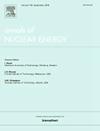Modification to aerosols dispersion algorithms over two-dimensional hilly terrain based on wind tunnel atmospheric experiments
IF 1.9
3区 工程技术
Q1 NUCLEAR SCIENCE & TECHNOLOGY
引用次数: 0
Abstract
Accurate prediction of aerosol atmospheric dispersion concentration distribution in airborne effluents from nuclear power plants is very important for environmental assessment and nuclear accident emergency response. This study focuses on the plume dispersion centerline trajectory and concentration distribution of aerosols in the atmospheric boundary layer over a two-dimensional hill model under neutral atmospheric conditions. Through laser measurements in active atmospheric dispersion wind tunnel experiments, the flow field around the hill and the aerosol dispersion concentration distribution released at different heights were obtained. According to the streamlines and considering the lifting effect of hill on plumes, a modification algorithm for plume centerline trajectories and concentration distribution in hilly terrain based on Gaussian dispersion model was proposed. The plume centerline trajectory and concentration distribution simulated by the modification algorithm and Plume Path Coefficient Treatment are compared with the experimental results. The results showed that due to the influence of clockwise circulation on the leeside of the hill, the aerosol dispersion trajectory was separated from the shape of the hill. The modification algorithm has better agreement with the experimental results, with NMSE and FB in , in the simulation of the plume centerline trajectory. For the simulation of concentration distributions, the modification algorithm slightly underestimates, but is more stable than Plume Path Coefficient Treatment, which has the performance that goes from far overestimation to underestimation along the downwind direction. This study can provide an accurate evaluation of aerosols atmospheric dispersion over hilly terrain.
求助全文
约1分钟内获得全文
求助全文
来源期刊

Annals of Nuclear Energy
工程技术-核科学技术
CiteScore
4.30
自引率
21.10%
发文量
632
审稿时长
7.3 months
期刊介绍:
Annals of Nuclear Energy provides an international medium for the communication of original research, ideas and developments in all areas of the field of nuclear energy science and technology. Its scope embraces nuclear fuel reserves, fuel cycles and cost, materials, processing, system and component technology (fission only), design and optimization, direct conversion of nuclear energy sources, environmental control, reactor physics, heat transfer and fluid dynamics, structural analysis, fuel management, future developments, nuclear fuel and safety, nuclear aerosol, neutron physics, computer technology (both software and hardware), risk assessment, radioactive waste disposal and reactor thermal hydraulics. Papers submitted to Annals need to demonstrate a clear link to nuclear power generation/nuclear engineering. Papers which deal with pure nuclear physics, pure health physics, imaging, or attenuation and shielding properties of concretes and various geological materials are not within the scope of the journal. Also, papers that deal with policy or economics are not within the scope of the journal.
 求助内容:
求助内容: 应助结果提醒方式:
应助结果提醒方式:


